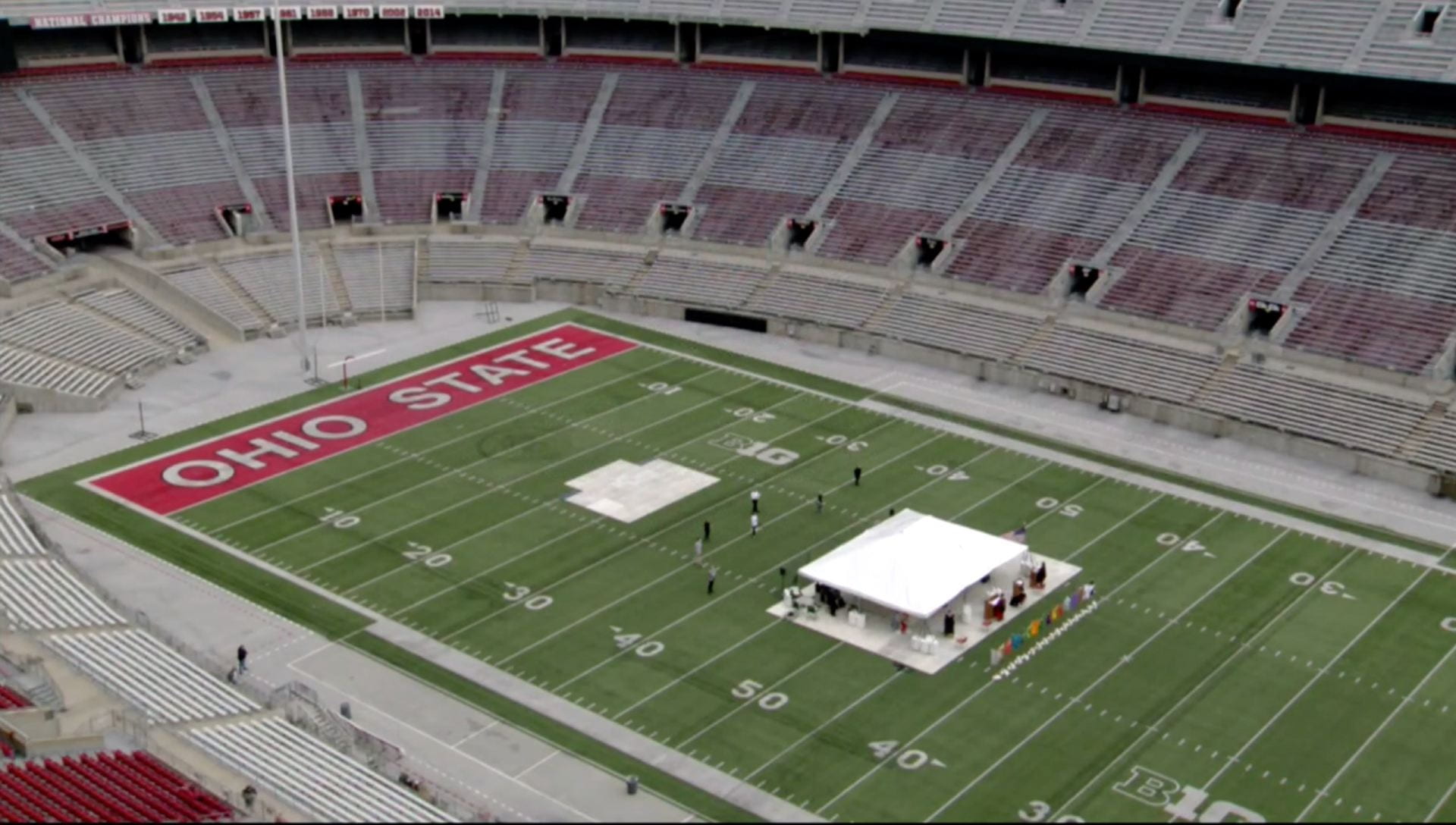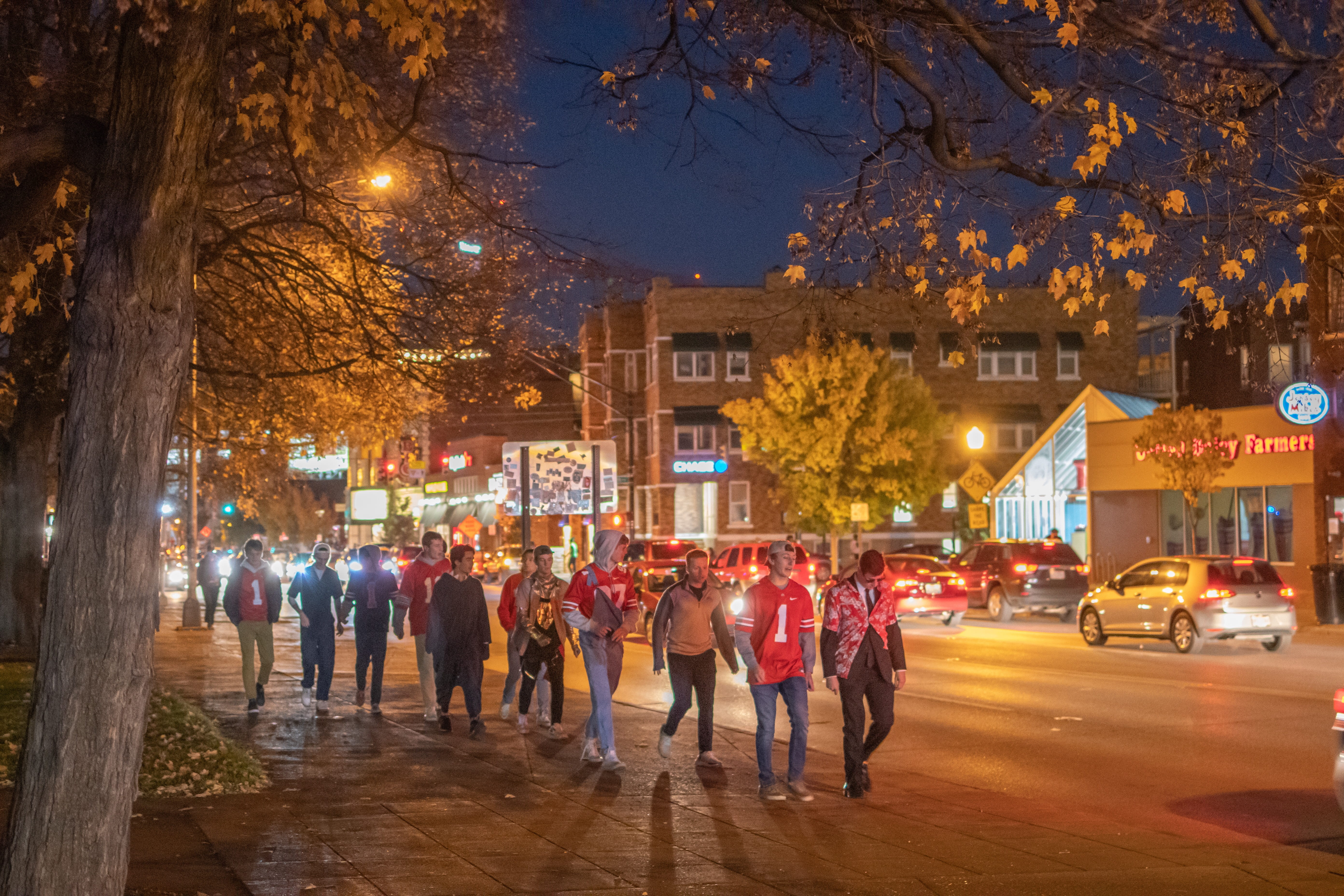
Ohio State’s March 9, 2020 suspension of in-person suspension was only supposed to last two weeks. Instead, it turned into a semester and a half of entirely virtual instruction and a full academic year of hybrid instruction with strict health and safety guidelines. Credit: Mackenzie Shanklin | Photo Editor
Kaitlyn Stacy, like many Ohio State students at the time, was enjoying her spring break when what felt like the end of the world started.
Stacy, now a third-year in actuarial science, said she was on a cruise March 9, 2020 — the first day of spring break and the day Ohio State announced it would suspend in-person classes to prevent the spread of COVID-19.
The suspension was only supposed to last two weeks. Instead, it turned into a semester and a half of entirely virtual instruction and a full academic year of hybrid instruction with strict health and safety guidelines.
The first outbreaks of COVID-19 began in Wuhan, China, in early 2020 and spread across the world in a matter of weeks. By Jan. 29, 2020, less than 70 cases of about 6,000 were outside of China with 132 deaths, according to the World Health Organization.
But by March 9, cases grew to more than 113,000 and nearly 4,000 deaths, according to Johns Hopkins University.
Exactly one year later, total known cases sit in the hundreds of millions with 2,607,782 deaths worldwide, according to Johns Hopkins University.
Ohio State began implementing restrictions on university-sponsored travel to countries with the virus Jan. 30, 2020. China was the first country, with South Korea, Iran and Italy joining the list by Feb. 29, 2020. However, at the end of January, many perceived the virus as nothing worse than the flu.
Any country classified Warning Level Three by the Centers for Disease Control and Prevention — meaning there was a high level of coronavirus spread — was placed under university travel restrictions March 6, 2020.
The first COVID-19 cases in Ohio were confirmed March 9, and Gov. Mike DeWine declared a state of emergency that same day.
Amy Fairchild, dean of the College of Public Health, said she began to participate in small meetings prior to spring break to plan what the future of Ohio State would be like amid COVID-19.
“Without the benefit of modeling, we were taking the best evidence that we knew, which was really shifting very rapidly at that time,” Fairchild said. “And trying to make the best forecasts that we could really in the face of enormous uncertainty.”
Stacy said she was also uncertain — if she would be stuck on the cruise, where she was going to live, if the suspension was going to be extended and just about everything else in between.
“We were kind of terrified that we were going to get stuck on the cruise in addition to worrying about whether school was getting canceled or not,” Stacy said. “We actually ended up buying internet for the cruise so we could keep up with whatever was going on at school and everything, and just make sure that we were going to be able to get off the boat.”
Stacy said they got off the boat March 13, 2020 — the day after Ohio State extended spring break by one week and suspended in-person classes for the rest of the spring semester.

Then-Ohio State President Michael V. Drake held a press conference at Bricker Hall March 10, 2020 about the university’s decision to suspend face-to-face instruction until at least March 30, 2020. Credit: Jack Long | Managing Editor for Digital Content
“It was kind of a period of where you spend a lot of time orienting yourself and then you’d have to reorient and reorient and reorient so it was, it was almost constantly recalibrating,” Fairchild said.
The switch to online classes brought about concerns from students and professors alike. According to a 2018 survey at Ohio State, 58.4 percent of students had at least one professor who did not regularly use Carmen Canvas — the university’s learning management system that was about to become the foundation of tens of thousands of students’ educations.
Judson Jeffries, a professor in African American and African studies, said the adjustment was challenging and he had to “pare down” his syllabi without losing the rigor of his courses to accommodate for the difficulty of the time.
He said he adjusted his syllabi to make the workload manageable for students who were taking four to six other classes and was flexible with grading and deadlines because of the circumstances of the pandemic and virtual instruction, such as some students not having access to the same quality of internet.
“At the end of the day, it worked out, but at the very beginning, it was a bit scary,” Jeffries said.
Akhila Boda, a first-year in biomedical science who was taking courses for college credit at Ohio State at the time, said she noticed a change in what she was retaining once courses went online and professors began recording lectures.
Boda said she used to have 8 a.m. lectures, but after the shift, attendance was sparse.
“They would record those lectures and there would just be this disconnect between what I bet students were retaining and what the professor was trying to teach,” Boda said. “It just wasn’t working.”
And while balancing a new method of learning and being away from friends, students had to adjust to another change — taking college classes from home.
“I just had a hard time being able to focus long enough to learn; it was really hard for me to be sitting in my childhood room staring at a computer being expected to be learning the same things as I would in a quiet classroom,” Stacy said.
Virtual instruction was extended through the summer term April 1, 2020, and spring commencement was held to a remote audience from an empty Ohio Stadium. By the end of May 2020, the status of the fall semester at Ohio State was still unknown.

University leaders conduct a livestreamed commencement ceremony from an empty Ohio Stadium. Credit: Courtesy of Ohio State
Amid nationwide outcries for social justice following the killing of George Floyd in Minneapolis police custody May 25, 2020, Ohio State announced June 3 — the seventh consecutive day of protest and demonstrations in Columbus and in some instances on Ohio State’s campus — it would have students on campus for fall semester with the last two weeks held virtually — just hours after confirming Kristina M. Johnson as the next university president.
Fairchild, a co-chair of the return to campus team and chair of the comprehensive monitoring team, said Johnson’s arrival as the summer wound down was crucial in the return-to-campus process.
“That was when things really began to take shape, where we pulled together the comprehensive monitoring team, identified the experts who needed to be brought together on a daily basis to look at the data,” Fairchild said.
Fairchild said the team pulled together data from various streams into analytics to provide real-time analysis of the pandemic’s ongoing developments, but the real changes came in implementing and enforcing the university’s mandatory surveillance testing program.
Between Aug. 6, 2020, and March 8, 2021, Ohio State administered 473,023 COVID-19 tests, according to the university COVID-19 dashboard.
“The testing protocol is not just for the sake of knowing, it has served two purposes,” Fairchild said. “Again, it allowed us to take individuals out of the population, out of circulation, who are infected, take their contacts out of circulation, so that we could prevent the infections of multitudes of other people and then begin to target interventions if we were seeing hotspots or clusters.”
Mandatory face-masks, COVID-19 surveillance testing and spaced out classes were among the many changes the university implemented to limit the spread of the coronavirus. And nearly half of all courses were entirely online fall semester, up from 6 percent of courses the year before, according to the Board of Trustees Academic Affairs and Student Life Committee. About a third of classes were offered in person, with 21 percent of courses offered in a hybrid format. Despite the changes to student life, Stacy said she still had hope for a relatively normal last year at Ohio State.
The fall semester was anything but.
The status of the football season itself was unknown going into the start of the academic year. While some conferences had greenlit play, the Big Ten announced Aug. 11, 2020, that fall sports would be canceled for the 2020 season — but Johnson and Ohio State athletic director Gene Smith were against the decision.

Led by the Football Parents at Ohio State, a protest against the Big Ten’s handling of the fall sports season was held outside Ohio Stadium Aug. 29. Credit: Keaton Maisano | Sports Editor
After public outcry, petitions and protests, the Big Ten announced Sept. 16, 2020, that football would return for a shortened, conference-only season beginning Oct. 23, 2020.
However, there was a catch — the games would be played without fans in attendance.
“I was so excited to go to football games and have a home Michigan game and all of that and even in the summer, that was still up in limbo and there was still, I guess, hope being held out that we were going to be able to do something until I guess part of the way through fall semester then that football hope turned into basketball or hockey hope. Just to have something to do or to have a really great spring break this year,” Stacy, who is graduating in the spring, said. “It’s been a lot just to get used to the idea of all of these plans that I guess we had or sort of had, that just kind of got taken away and turned into sitting at your desk in your room all day.”
Stacy and Boda said the fall semester took its toll on their mental health. They weren’t alone in their burnout from the semester, which was compounded by the university canceling the 2021 spring break and replacing it with two mid-week “instructional breaks.”
“If I’m being completely honest, it was by far the worst semester I’ve ever had,” Boda said.
Surveys conducted by the university and Undergraduate Student Government showed declining mental health among students and faculty over the course of the fall semester.
The university survey, sent out by the Office of the Chief Wellness Officer, was completed by 3,589 students, faculty and staff. Seven out of 10 student respondents and 37 percent of faculty and staff respondents reported feeling burnt out or burning out by December 2020.
Students who “screened positive” for anxiety increased from 39 percent in August to just more than 51 percent in December, with depression also increasing from 24 percent to 33.4 percent, according to the report of the university survey.
USG’s November 2020 survey of more than 7,000 students showed 57 percent of student respondents felt they did not understand the material for the courses they were taking, and 58 percent felt unmotivated to complete their coursework.
“I feel like those harder science classes are meant to be taken in person so that you can directly right away ask your professor if you have questions,” Boda said. “Even classes like organic chemistry, the whole visualization has to happen in person for you to be able to understand it well and making it all virtual, it kind of ruined the entire purpose of the class.”
Boda said she did not perform as well as she would have liked to in the fall semester — both academically and socially.
“I think I definitely didn’t make as many friends as I think I would have if it had been in person,” Boda said.
Boda said she joined a few clubs to meet people virtually and has tried to talk to others in her major.
Other Ohio State students, however, took to pre-pandemic ways of socializing — even though football games were played without fans in the stadium, students still flocked to large, off-campus gatherings to celebrate the traditional Ohio State football experience.
After Oct. 24, 2020, the university’s COVID-19 cases surged from under 100 per day to more than 100 per day between Nov. 7-17, 2020, the highest numbers of reported cases since late August and early September, which saw days with more than 200 cases per day, according to the university COVID-19 dashboard.
The university announced Nov. 19, 2020, that effective Nov. 20 at 6 p.m., the remainder of the semester would be virtual, extending the previously planned virtual instruction period by three days.
Students spent the end of November, the first few weeks of December and then the first two weeks of January taking online classes. In-person classes for the spring semester resumed Jan. 25.
COVID-19 cases remained low for the first month of the spring semester. However, the on-campus rate doubled between Feb. 24 and March 2 and twice-a-week testing became mandatory for on-campus students after 92 out of 9,063 on-campus students tested positive, raising the university’s seven-day positivity rate above 1 percent for the first time since January, according to the dashboard.
But with the rise of COVID-19 vaccination distribution, students said they feel things are looking up for the future.
“I think that with the vaccine things are heading in the right direction, I’m hoping sooner rather than later students are able to take it,” Boda said. “I’m hoping that will push things in the right direction.”
To view more of The Lantern’s coverage of COVID-19, beginning Jan. 29, 2020, click here.
For a behind-the-scenes look into student journalism across the state of Ohio amid the initial COVID-19 outbreak, click here.






